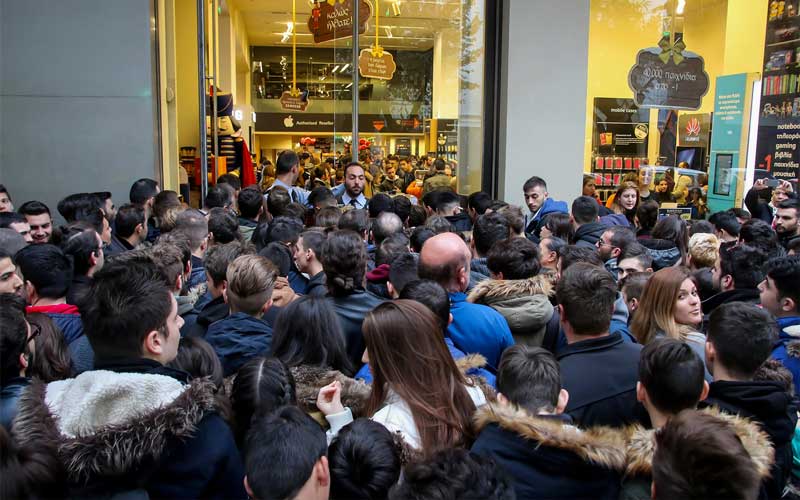
Between Black Friday and Cyber Monday, this coming weekend is the busiest four-day stretch for retailers in the entire year. With millions of shoppers headed to stores and even more buying online, retailers are looking for ways to improve the shopping experience to add more customers and raise basket averages. Increasingly, they’re turning to new technologies like machine learning to modernise shopping, drive dynamic pricing, and make the behind-the-scenes work of inventory and fulfilment more efficient.
Machine learning involves training computers to notice patterns and make decisions based on those patterns. In retail, machine learning is helping stores to learn more about their customers, what they’re looking for, and what price they’re willing to pay. According to Accenture, 3/4 of all retailers believe that machine learning in combination with big data is changing the way they do business. Machine learning has been shown to optimise prices and improve customer satisfaction while increasing profit margins for retailers. In this article, we’ll take a deep dive into how machine learning is revolutionising retail, and there’s no better place to see it on display than Black Friday.
Black Friday Shopping is Exploding, Online and In-Stores
Black Friday is the third Friday in November, the day after Thanksgiving in the United States, where Black Friday originated in the 1950s. Since then, American retailers have used Black Friday as an opportunity to promote the Christmas shopping season. Traditionally, stores open early and offer promotional sales over the course of the four-day Thanksgiving holiday weekend.
American retailers first began introducing Black Friday sales in the UK in the early 2000s. Since Amazon’s introduction of UK Black Friday sales in 2010 and Asda’s follow-up in 2013, adoption has gradually spread to UK-based retailers as well. The Guardian reported in 2016 that UK shoppers spent £10.1 billion in the week including and following Black Friday. Most of that shopping was online where us Brits spent £1.74 million per minute online on Black Friday 2016.
The same can be said for the United States, where most Black Friday shopping is also now done online, reaching over $3 billion last year. This year in both the US and UK, retail sales are expected to increase another 3.6% to 4% year-over year overall, with most of the growth coming from online shopping. However, Black Friday is still by far the busiest shopping day in-stores as well, with retailers offering special in-store promotions.
While Black Friday is now a huge shopping phenomenon in the US and UK, it is also starting to catch on elsewhere. In Canada, shoppers traditionally hopped across the border to experience Black Friday in the US, but in 2012 retailers started pushing to get Canadians to spend more of their dollars on home turf. Last year in 2016, almost half of Canadians in one poll said they shopped for Black Friday deals.
Elsewhere in Europe, Black Friday has been slow to catch on. However, in 2016 Germans spent €1 billion on the event. In a growing global trend, more companies are trying to introduce Black Friday in countries across the globe from Australia to South America. I expect we will see its continued expansion well into the future, especially with the growth of online shopping in the developing world.

How Machine Learning is Changing Retail
Machine learning is the process of teaching computers to make decisions without explicitly programming them to make those decisions. It allows computers to work in varied situations with complex, often unpredictable inputs where it would be impossible to code a simple answer. Instead, computer scientists train their machines on large data sets where the computers can learn what works and what doesn’t over the course of thousands of attempts. The result is dynamic outputs based on complex inputs. If you’ve used Amazon’s product recommendations, Facebook’s tag a friend photo recognition, fraud detection services on most credit cards, or Siri’s language processing, then you’ve interacted with machine learning.
Machine learning, big data, and automated customer interactions are the future of retail. According to research from Gartner, 85% of customer interactions will be human-less by 2020, taking place either online or via self-checkout in stores. This decrease in human labour in retail correlates with an increased reliance on machine learning to make product recommendations, facilitate customer support, and organise inventory and logistics.
For example, Amazon currently uses machine learning to categorise the items you’ve viewed online and made recommendations. However, they also use machine learning to analyse who will buy what, at what price, and when, allowing the company to set dynamic prices, plan inventory, and time shipments with incredible accuracy. Other retailers, both online and brick-and-mortar, are using machine learning in similar ways. The result is these companies are able to keep prices low for customers while boosting operating margins by up to 60%.
Machine Learning on Black Friday
Since Black Friday is the biggest shopping day of the year for most retailers, the difference in profit margin and customer experience between retailers using machine learning and those who aren’t can be significant. Machine learning is about making smarter decisions in preparation for Black Friday, testing thousands of possible options to maximise sales. On the big day, machine learning can help retailers set prices, identify problems, handle basic customer support, and move customers through the checkout process quickly.
On Black Friday, machine learning will have different applications depending on whether it’s deployed in stores or online.
In-stores
Machine learning will be key in brick-and-mortar retailers’ preparation prior to Friday. For instance, machine learning algorithms can run simulations of possible store layouts to help identify choke points and ideal locations for product placement. Other machine learning algorithms can analyse in-store inventory and warehouse stock alongside demographic and customer data to optimise the distribution of certain types of products to various stores ahead of Friday’s sales, predicting which items will sell where.
On Friday, machine learning will help to set store prices. It will also integrate with checkout systems to provide real-time sales data for managers and executives to track profits and proactively identify problems. The same goes for in-store cameras, some of which now integrate facial tracking and recognition to monitor customers.
Advanced applications of machine learning that you might see in future Black Fridays include developments from Microsoft that utilise facial recognition that can identify when customers are confused or upset, directing employees to offer assistance. It’s possible that the same cameras could monitor customers’ shopping baskets to identify other products that might interest them and offer those products on screens throughout the store.
Online
In addition to in-store shopping, Black Friday has quickly become the busiest day for online shopping as well. According to a report from Adthena, online page views for retailers increase 220% on Black Friday over the average for the rest of the year. Online retailers are using machine learning to optimise their advertising, sales funnels, and upsells in order to get the most out of Black Friday’s uptick in views.
One essential implementation of machine learning that has become ubiquitous across all major e-commerce sites is product recommendations. Chances are, if you shop online this Friday (or any day of the year) you’ll see a host of other products that the retailer recommends you buy to complete your order. On Black Friday, these recommended products will have an added layer of curation to point customers toward special promotions and inventory that the online retailer is eager to move.
Online retailers are also using machine learning to drive customer acquisition. New algorithms allow companies to make changes to ad preferences as advertising prices and A/B testing results come in throughout the day. These algorithms can provide up-to-the-minute recommendations to the ad team to change or invest more heavily in certain types of advertising. In 2016, River Island, utilised dynamic ad price monitoring to see a 54% increase in page views and an 84% increase in sales year-over-year.
In conclusion
If you buy something from a major retailer this Friday, whether online or in-person, chances are machine learning will be involved in some way in your transaction. Retailers are using machine learning to fine-tune inventory, store layout, pricing, product recommendations, and customer service to make shopping easier. While the effects of machine learning are most evident on Black Friday, they continue throughout the year as well, gradually revolutionising every part of the retail shopping industry.
If you enjoyed reading this article, check out my other articles on How AI Will Impact the Customer Experience and How Machine Learning Improves Customer Lifetime Value. I’ll be publishing more articles about machine learning and retail over the coming months, so you can follow me on LinkedIn to stay tuned.
Get our latest articles and insight straight to your inbox
Hiring data professionals?
We engage exceptional humans for companies looking to unlock the potential of their data